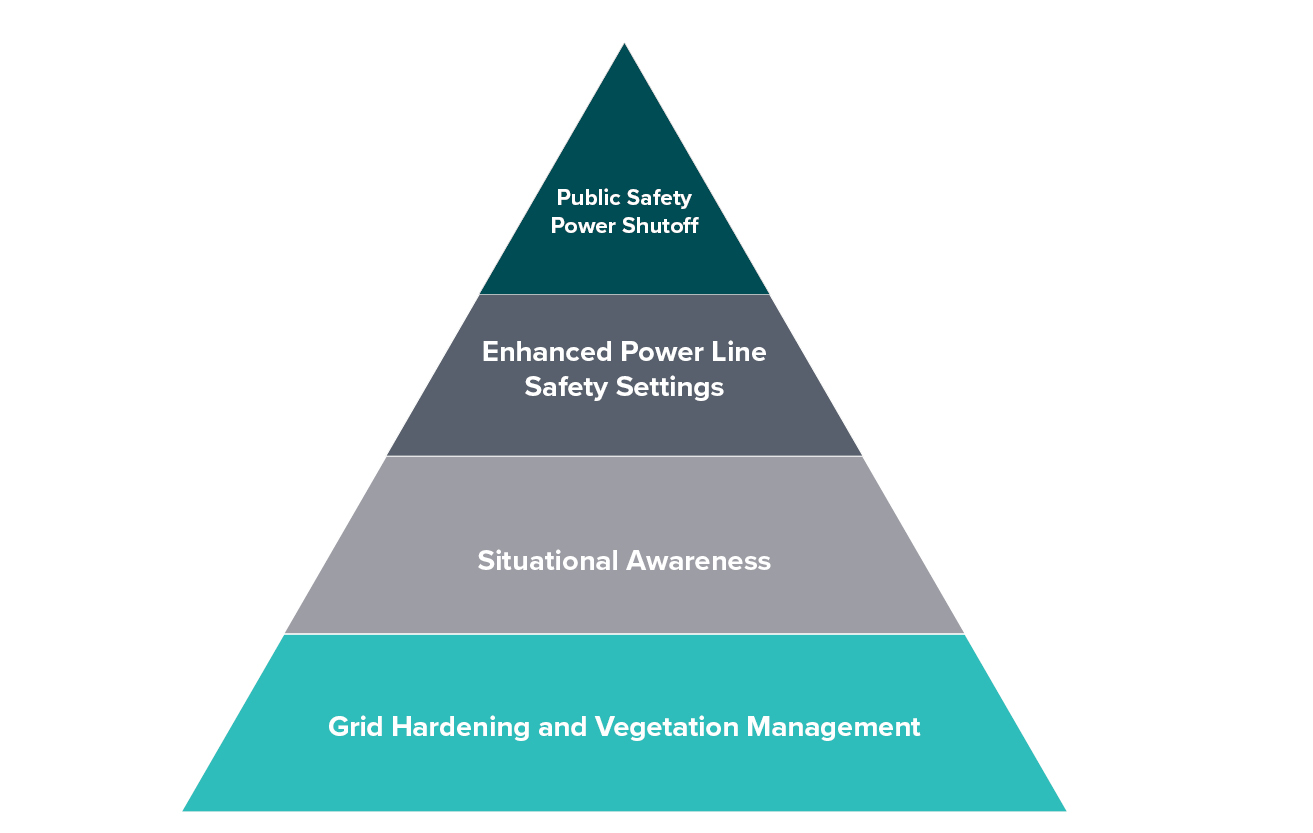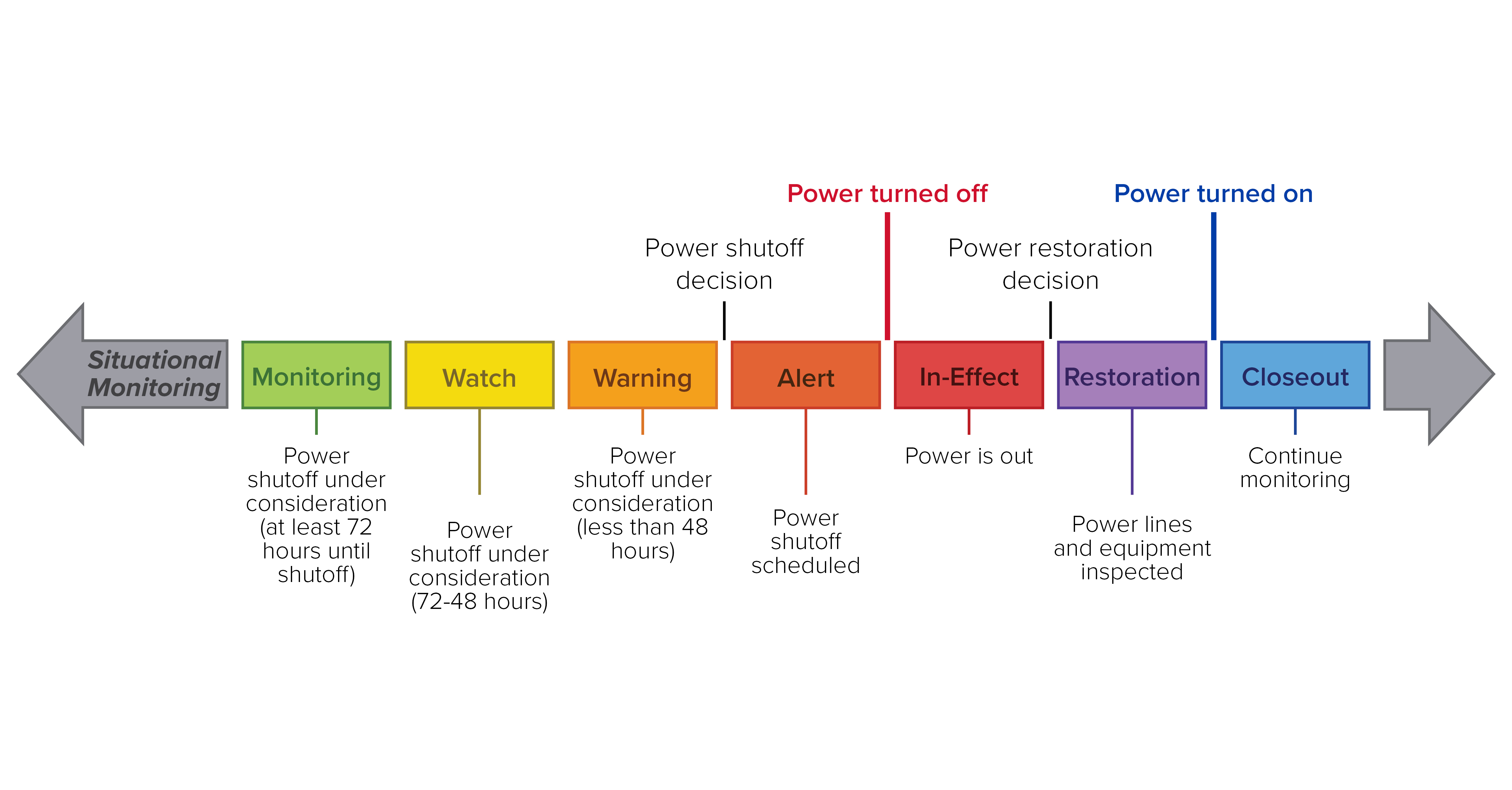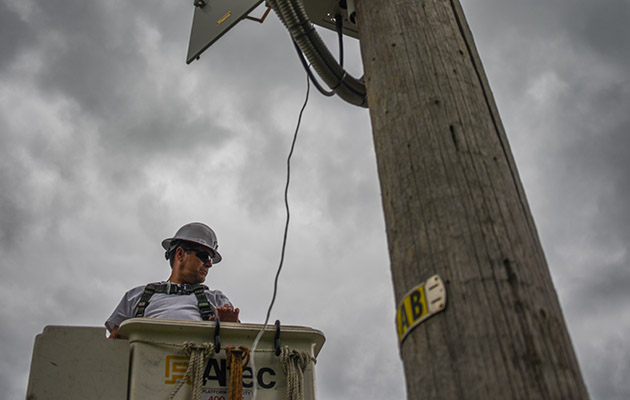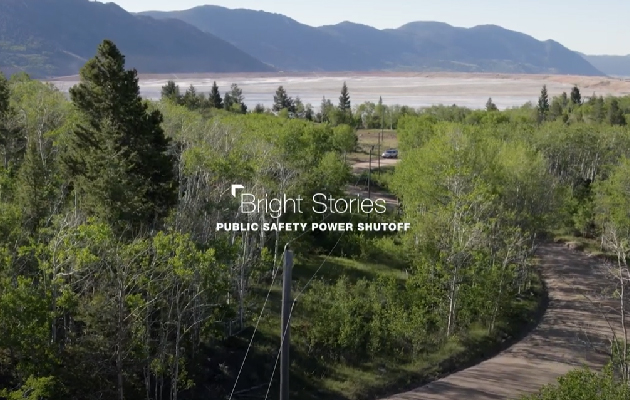Public Safety Power Shutoff
Our emergency line is available 24 hours a day.
Montana: 888-467-2669 | South Dakota/Nebraska: 800-245-6977 | In case of a life-threatening emergency, dial 911.
Public Safety Power Shutoff Map
During a Public Safety Power Shutoff event, this map will show an approximate outline of the affected area.
Tips for using the Public Safety Power Shutoff Map:
- During a Public Safety Power Shutoff event, the approximate outline of the affected area will be visible on the map.
- Click on the colored area for details.
- Check back regularly, as the map will be updated with the latest information.
Note: The outlines shown on this map are an approximation of the affected area. If you are going to be impacted by a Public Safety Power Shutoff, we will attempt to contact out to you directly via the email address and/or phone number we have on file.
Login to My Energy Account to update your information.
Measure of Last Resort

Measure of Last Resort
Public Safety Power Shutoffs are a measure of last resort. Our Wildfire Mitigation Plan includes numerous strategies to prevent our power lines from sparking a wildfire. One of these strategies is enabling Enhanced Powerline Safety Settings.
Public Safety Power Shutoffs are used only in extreme situations during severe fire weather.
What are the different stages of a Public Safety Power Shutoff event?
Our Public Safety Power Shutoff strategy includes a clearly defined, phased approach that guides us in the decision to implement a shutoff.
During each stage of the process, we are assessing the need for a public safety power shutoff. During any stage, we may decide a proactive outage is not needed.

If your home or business will be impacted by a Public Service Power Shutoff, you will hear from NorthWestern Energy a number of times throughout the process. NorthWestern Energy is committed to providing as much advance notice as reasonably possible to help you prepare for a PSPS event.
- Monitoring - As fire danger increases, NorthWestern Energy will closely monitor the situation and assess the need for a Public Safety Power Shutoff. As soon as we enter the "PSPS monitoring" phase, our website will be updated with information, and we will reach out to local community agencies, such as police, sheriff and fire departments.
- Watch - When we reach the stage of "PSPS watch," customers who may be impacted will receive an automated call from NorthWestern. We will continue to update our website and reach out to media organizations and community leaders.
- Alert - If a PSPS becomes imminent, we advance to the "PSPS alert" stage. At this point customers will be contacted again via a call campaign. Community members, media and stakeholders will be notified as well.
- Shutoff In-Effect - When we de-energize our power lines, we will continue to update our website as we monitor the situation.
- Closeout - When we restore power, impacted customers will receive another automated call to let them know power has been restored.
What is a Public Safety Power Shutoff?

What is a Public Safety Power Shutoff?
What triggers a Public Safety Power Shutoff?
Heat
Low humidity
High Wind
Dry vegetation
Public Safety
How will I be notified of a Public Safety Power Shutoff?
Automated Phone Calls
NorthWestern Energy website
NorthWestern Energy Outage Map
Social Media
Text Message
Paid Advertising
(Radio, TV, etc.)
2025 Public Safety Power Shutoff Implementation Plan
Public Safety Power Shutoffs: Frequently Asked Questions
What’s the difference between a Public Safety Power Shutoff and a rolling blackout?
During a Public Safety Power Shutoff, NorthWestern Energy will shut off power to certain lines in areas where wildfire risk is unacceptably high due to extreme weather conditions. This is done proactively before a wildfire starts burning.
This is different than a rolling blackout, when power is shutoff to stabilize the grid during periods of peak demand.
What if I have special medical needs and depend on electricity?
- Make a plan for medical needs such as refrigerated medicine or electrically powered medical equipment. This could mean finding a place you can go during an outage or using a backup generator.
- For medical emergencies, call 911.
How can I prepare for Public Safety Power Shutoff events?
Be sure NorthWestern Energy has your current phone number and email address. Update your contact information by logging in to My Energy Account or by calling us at 888-467-2669.
Make a plan:
- Prepare for medical needs, such as refrigerated medicine or electrically powered medical equipment.
- Build a summer outage kit that includes bottled water, non-perishable food, baby food or formula and diapers, pet food, medications and other necessities. Keep a block of ice in the freezer.
- Plan for a way to feed and water pets or livestock in case well pumps don’t have power.
Stay safe if the power goes out:
- Turn off all but one light, so you will notice when we have restored your electricity.
- Unplug computers, chargers, TVs, VCRs and other sensitive appliances to avoid possible damage when electricity is restored.
- When power resumes, reset clocks and check automatic alarms and timers. Plug in only essential items. Wait 10 minutes before connecting the remainder of your items to let the electrical system stabilize.
- Do not open freezers or refrigerators more than necessary. A refrigerator will keep food cold for about 4 hours if it is unopened. A full freezer will keep the temperature for approximately 48 hours (24 hours if it is half full) if the door remains closed.
- If you see a downed or damaged power line, keep your distance and call 911 immediately. Assume all power lines are energized. Never touch a power line or any object, including trees, that is in contact with a line.
Learn more about Public Safety Power Shutoffs
How will I be notified if there is a Public Safety Power Shutoff in my area?
If you will be impacted by a potential Public Safety Power Shutoff, NorthWestern Energy will notify you directly multiple times throughout the process. You will receive an automated phone call and email from us before power is turned off and after it is restored.
However, we can only contact you if we have your correct contact information. Update your contact information by logging in to My Energy Account or by calling us at 888-467-2669.
NorthWestern Energy will also post information on our website and social media accounts about Public Safety Power Shutoffs. For the most up-to-date information during an event, visit NorthWesternEnergy.com.
How long does a Public Safety Power Shutoff last?
Public Safety Power Shutoffs can vary in length. We will not restore power until weather conditions have improved to the point where we can safely operate the electrical grid. After the extreme weather conditions have passed, we will patrol electrical lines to make sure no branches, trees or other items have fallen into the lines. Once any damage has been repaired, NorthWestern Energy will restore power. A Public Safety Power Shutoff, plus the time to patrol and make repairs, could last several hours or even days. If storm damage occurs, restoration could take longer.
What happens during a Public Safety Power Shutoff event?
At least 48 hours before most Public Safety Power Shutoffs, NorthWestern Energy will notify customers who may be impacted. We will continue to update our customers as we monitor the situation and determine whether a power shutoff is necessary. Before power is turned off, all impacted customers will be contacted via phone and email (if we have your email address on file). Power will remain off until weather conditions have improved to the point where we can safely operate the electrical grid.
Customers will also be notified when their power has been restored.
Be sure NorthWestern Energy has your current phone number and email address. Update your contact information by logging in to My Energy Account or by calling us at 888-467-2669.
Where do Public Safety Power Shutoffs occur?
All customers should be prepared for outages, including Public Safety Power Shutoffs. Public Safety Power Shutoffs are most likely to occur where homes and other structures are built in wildfire-prone areas. This can include forested areas on the outskirts of larger towns or cities, or rural forested areas. However, a Public Safety Power Shutoff could also be needed near prairies, grasslands and farms. The least likely place to have a Public Safety Power Shutoff is in a populated, urban area.
When do Public Safety Power Shutoffs occur?
Public Safety Power Shutoffs are used only during extreme weather conditions when there is a high risk of an electrical line igniting a wildfire. The primary factors we look at to determine when a Public Safety Power Shutoff is necessary are high temperatures, low humidity, dry vegetation and high wind.
We may turn off power when extreme weather conditions are expected but before they hit an area.
Public Safety Power Shutoffs are most likely to occur during fire season – the hot dry months in the summertime. However, it is possible to have a Public Safety Power Shutoff anytime of the year when it’s hot, dry and windy.




